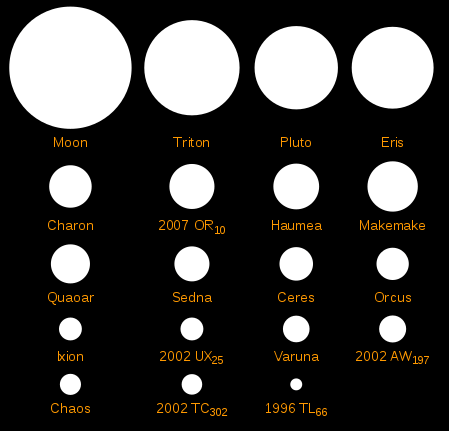19521 Chaos
| Discovery | |
|---|---|
| Discovered by | Deep Ecliptic Srvy. |
| Discovery date | 19 November 1998 |
| Designations | |
| MPC designation | (19521) Chaos |
| Pronunciation | /ˈkeɪ.ɒs/ |
Named after | Chaos |
| 1998 WH24 | |
| TNO (cubewano)[1][2] | |
| Adjectives | Chaotian |
| Orbital characteristics[3] | |
| Epoch 13 January 2016 (JD 2457400.5) | |
| Uncertainty parameter 3 | |
| Observation arc | 5902 days (16.16 yr) |
| Earliest precovery date | 17 October 1991 |
| Aphelion | 50.636 AU (7.5750 Tm) |
| Perihelion | 40.957 AU (6.1271 Tm) |
| 45.796 AU (6.8510 Tm) | |
| Eccentricity | 0.10567 |
| 309.92 yr (113199 d) | |
Average orbital speed | 4.3931 km/s |
| 337.2998° | |
| 0° 0m 11.449s / day | |
| Inclination | 12.0502° |
| 50.0239° | |
| 58.4097° | |
| Jupiter MOID | 35.8 AU (5.36 Tm) |
| Neptune MOID | 12.5 AU (1.87 Tm)[4] |
| TJupiter | 5.884 |
| Physical characteristics | |
| Dimensions |
600+140 −130 km [5] |
Sidereal rotation period | 3.985 d |
|
0.050+0.030 −0.016 [5] | |
|
4.8[3] 5.0 [6] | |
|
| |
19521 Chaos /ˈkeɪ.ɒs/ is a cubewano, a Kuiper-belt object not in resonance with any planet. It is a likely dwarf planet. Chaos was discovered in 1998 by the Deep Ecliptic Survey with Kitt Peak's 4 m telescope. Its albedo is 0.050+0.030
−0.016,[5] making it, with its absolute magnitude (H) of 4.8,[3] 600+140
−130 km in diameter.[5] It is named after the primeval state of existence in Greek mythology, from which the first gods appeared.
Orbit and rotation
19521 Chaos has an orbital period of approximately 309 years. Its orbit is longer, but less eccentric than the orbit of Pluto. 19521 Chaos's orbit is inclined approximately 12° to the ecliptic. Its orbit never crosses the orbit of Neptune. Currently, the closest approach possible to Neptune (MOID) is 12.5 AU (1.87 billion km).[4]


In fiction
In the online comic Quantum Vibe the lead characters hide on a secret base they have constructed on Chaos to perform experiments undetected.[7]
References
- ↑ "MPEC 2008-O05 : Distant Minor Planets (2008 AUG. 2.0 TT)". Minor Planet Center. 17 July 2008. Retrieved 2011-01-08.
- ↑ Marc W. Buie (2004-11-09). "Orbit Fit and Astrometric record for 19521". SwRI (Space Science Department). Retrieved 2008-09-28.
- 1 2 3 "JPL Small-Body Database Browser: 19521 Chaos (1998 WH24)" (2007-12-14 last obs). Retrieved 11 April 2016.
- 1 2 "(19521) Chaos = 1998 WH24 Orbit". IAU Minor Planet Center. Retrieved 2018-02-10.
- 1 2 3 4 “TNOs are Cool”: A survey of the trans-Neptunian region VI. Herschel/PACS observations and thermal modeling of 19 classical Kuiper belt objects E. Vilenius, C. Kiss, M. Mommert, T. Müller, P. Santos-Sanz, A. Pal, J. Stansberry, M. Mueller, N. Peixinho, S. Fornasier, E. Lellouch, A. Delsanti, A. Thirouin, J. L. Ortiz, R. Duffard, D. Perna, N. Szalai, S. Protopapa, F. Henry, D. Hestroffer, M. Rengel, E. Dotto, & P. Hartogh
- ↑ "How many dwarf planets are there in the outer solar system?". Michael E. Brown. Retrieved 15 September 2016.
- ↑ http://www.quantumvibe.com/strip?page=1013
External links
- Original Minor Planet Electronic Circular (1998-X08) for 19521 Chaos
- Revised Minor Planet Electronic Circular (1999-V03) 19521 Chaos
- AstDys
- 19521 Chaos at the JPL Small-Body Database

_(cropped).jpg)
